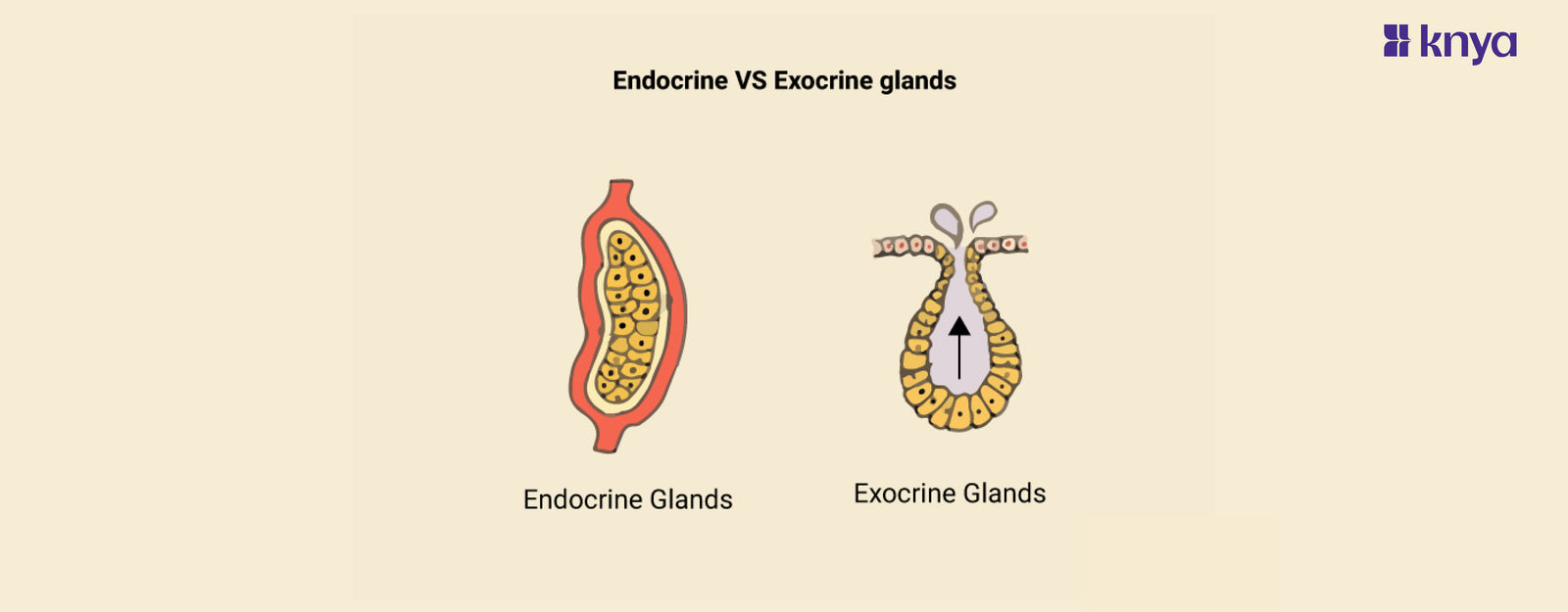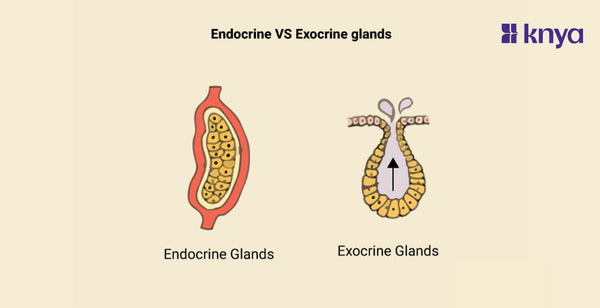Difference between Endocrine and Exocrine glands: Endocrine and exocrine glands are two main types of glands in the body, distinguished by how they release their secretions. Endocrine glands, also called ductless glands, release hormones directly into the bloodstream. These chemical messengers travel throughout the body to reach target organs, regulating various functions like growth, metabolism, and reproduction. Examples include the pituitary gland, thyroid gland, and adrenal glands. Exocrine glands, on the other hand, release their products through ducts onto body surfaces or into cavities. These secretions can be enzymes for digestion (pancreas and salivary glands), mucus for lubrication (respiratory glands), sweat for temperature regulation (sweat glands), or milk for nourishment (mammary glands).
[image_banner]
Endocrine Glands
- Secret Messengers: Release hormones directly into the bloodstream, which travel throughout the body to target organs.
- Hidden Helpers: Located inside body tissues, often tucked away deep like the thyroid or adrenals.
- Chemical Control Center: Influence a wide range of functions, from growth and metabolism to mood and reproduction.
- No Ducts, No Fuss: Don't have ducts; their secretions (hormones) dissolve into the bloodstream for delivery.
Exocrine Glands
- Product Pipelines: Release their products (enzymes, mucus, sweat) through ducts onto a surface or into a cavity.
- Visible Variety: Found throughout the body, from salivary glands in the mouth to tear glands in the eyes.
- Direct Delivery: Products act locally at the site of release, like digestive enzymes breaking down food in the stomach.
- Diverse Duties: Play crucial roles in digestion, lubrication, waste removal, and even temperature regulation.
Difference between Endocrine and Exocrine Glands
Endocrine and exocrine glands are two types of glands in the human body that perform separate functions in physiological balance maintenance. Let's dive into the differences between Endocrine and Exocrine Glands.
|
Feature |
Endocrine Glands |
Exocrine Glands |
|
Function |
Secrete hormones into the bloodstream |
Secrete substances via ducts to body surfaces or cavities |
|
Mode of Action |
Hormones travel through the bloodstream to target organs |
Secretions are carried through ducts to specific locations |
|
Target |
Affects distant target cells or organs |
Affects nearby cells or released onto external surfaces |
|
Ducts |
Lack ducts |
Have ducts |
|
Product Nature |
Produce and secrete hormones |
Produce enzymes, mucus, saliva, or other substances |
|
Examples |
Pituitary gland, thyroid gland, adrenal glands, pancreas |
Salivary glands, sweat glands, sebaceous glands, digestive glands |
|
Transport Medium |
Blood |
Ducts |
|
Target Range |
Widespread throughout the body |
Localized |
|
Location of Action |
Systemic |
Localized |
|
Speed of Action |
May take longer due to travel time in the bloodstream |
Often quicker due to local action |
|
Type of Secretion |
Hormones |
Enzymes, mucus, saliva, or other substances |
|
Duct Presence |
Lack ducts |
Have ducts |
|
Example |
Thyroid gland, pituitary gland |
Salivary gland, sweat gland, pancreas exocrine cells |
|
Distance of Action |
Acts on distant target cells |
Acts on nearby cells or surfaces |
|
Regulation |
Often regulated by feedback mechanisms involving hormones |
May be regulated by neural or hormonal signals |
What are Endocrine Glands?
Endocrine glands are often called ductless glands because they release their products, called hormones, directly into the bloodstream. Hormones travel throughout the body and regulate many important functions, like growth, metabolism, and mood. Examples of endocrine glands include the pituitary gland, which is often called the "master gland" because it controls other endocrine glands, the thyroid gland, which regulates metabolism, and the adrenal glands, which help the body respond to stress.
Key Features of Endocrine Glands:
- Secrete hormones: Endocrine glands release chemical messengers called hormones directly into the bloodstream. No ducts involved!
- Long-distance effects: Hormones travel through the blood, reaching target organs and tissues anywhere in the body, influencing diverse functions.
- Precise control: Hormone release is tightly regulated by feedback mechanisms, ensuring the right amount reaches the right target at the right time.
- Examples: Pituitary, thyroid, adrenal glands, pancreas (endocrine part).
[image_banner]
What are Exocrine Glands?
Exocrine glands have ducts that carry their secretions to the surface of the body or to internal cavities. These secretions can be enzymes, mucus, sweat, or other fluids. Exocrine glands play a variety of roles in the body, including digestion, lubrication, and waste removal. Examples of exocrine glands include the salivary glands, which produce saliva to help digest food, the sweat glands, which help regulate body temperature, and the mammary glands, which produce milk.
Key Features of Exocrine Glands:
- Secrete diverse substances: Exocrine glands produce various products like sweat, saliva, digestive enzymes, mucus.
- Ducts deliver: These substances are released through ducts directly onto body surfaces or into internal cavities like the digestive tract.
- Local action: Effects are usually localised at the site of secretion, impacting specific functions like digestion, lubrication, or temperature regulation.
- Examples: Sweat glands, salivary glands, pancreatic enzymes, intestinal lining.
Shop Best Lab Coats from Here!
Similarities between Endocrine and Exocrine Glands
- Epithelial cells can give rise to both endocrine and exocrine glands.
- Both Endocrine and Exocrine glands contribute to the body's equilibrium.
- Cellular Activity: Both entail specialised cell activity.
- Secreting Substances: Both are made up of glandular tissue that performs specific tasks.
While both types of glands contribute to our body's complex workings, the difference between endocrine and exocrine glands lies in their delivery systems and targets. Endocrine glands, often nicknamed "ductless glands," send their chemical messengers, called hormones, directly into the bloodstream. These hormones travel through our circulatory network, reaching distant target organs and influencing various processes, from growth and metabolism to reproduction and stress response.
| Check out More Articles | |
| Difference Between Psychosis and Neurosis | |
| Dorsal Vs Ventral | |
| Difference Between Striated and Unstriated Muscles | |















